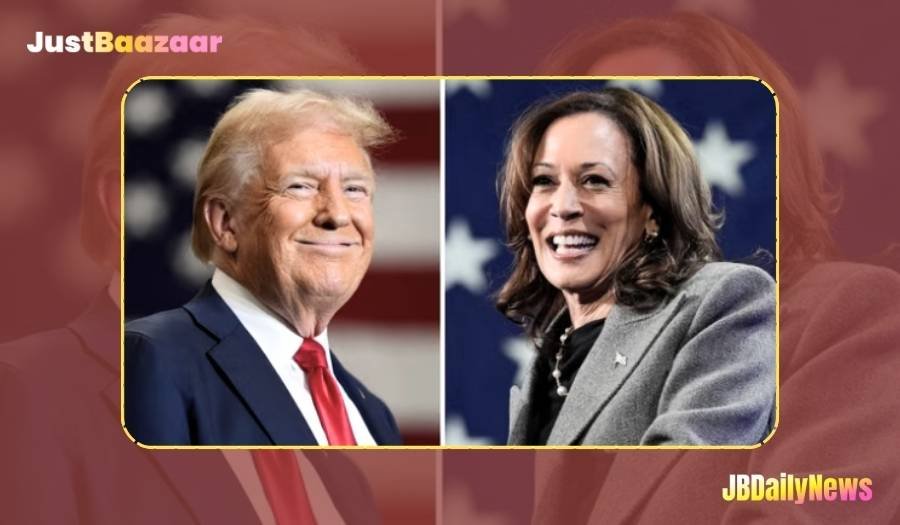As the 2024 U.S. presidential election approaches, Vice President Kamala Harris and former President Donald Trump find themselves in a neck-and-neck race, reflecting a polarized political landscape. With both candidates strategizing intensely in key battleground states, the race hinges on thin margins in regions critical to winning the Electoral College. Both candidates have distinct paths to victory, each relying on swing states where support fluctuates based on voter demographics and pressing national issues.
US Election 2024: A Tight Race Between Kamala Harris and Donald Trump

This article provides an analytical breakdown of each candidate’s strengths, weaknesses, and required strategies for securing victory in the election.
The Candidates and Their Paths to Victory
Kamala Harris, serving as Vice President under President Joe Biden, seeks to galvanize the Democratic base and secure support among key voting groups, including young voters, minorities, and women. Harris’s popularity in urban centers and among progressive voters has generally kept her in a favorable position within Democratic strongholds and certain swing states. Despite facing criticism for policy stances and performance in areas such as immigration, she benefits from the continuity of the Biden administration’s policies and a network of campaign endorsements from prominent Democratic figures.
Donald Trump, the former president, remains a divisive but formidable figure in American politics. After his 2020 defeat, Trump retained a strong Republican following, especially among rural voters, older demographics, and conservative-leaning independents. His campaign strategy focuses on the economy, crime, and a hardline stance on immigration, issues that resonate with his core base. Despite ongoing legal challenges, Trump’s supporters remain loyal, particularly in historically conservative areas and among voters disillusioned with the current administration’s policies.
Polling Analysis: A Tight Race Across Swing States
Nationally, polling data places Harris slightly ahead of Trump, but within the margin of error, reflecting a tight and unpredictable race. Recent surveys indicate that Harris leads Trump in critical swing states, including Michigan, Pennsylvania, and Wisconsin, while Trump holds slight advantages in North Carolina and Arizona. Georgia remains a virtual tie, emphasizing the crucial role of voter turnout in these battleground states
According to polling from Redfield & Wilton Strategies, Harris holds a narrow lead in four out of seven major battleground states, including Pennsylvania and Michigan, which are crucial for a Democratic victory. Trump, on the other hand, shows strength in the South, including North Carolina and Florida, which he is projected to win by a larger margin
. These state-by-state differences reflect each candidate’s unique appeal to distinct voter demographics and indicate the election may once again come down to a few pivotal counties within these battleground states.
Key Battlegrounds and Demographic Influences
The 2024 election will be determined by voter engagement and demographic shifts across several swing states. Here’s a look at the factors influencing key states:
- Pennsylvania: Traditionally a Democratic stronghold, Pennsylvania has become a swing state due to shifts in suburban voting patterns. Harris’s campaign focuses on urban centers such as Philadelphia and Pittsburgh, where voter turnout is essential. Trump, conversely, appeals to rural areas and former industrial regions experiencing economic challenges.
- Wisconsin and Michigan: These two states were instrumental in Biden’s 2020 victory. Harris’s support hinges on mobilizing labor unions, minority voters, and college students, while Trump appeals to disaffected working-class voters, especially in manufacturing sectors.
- Arizona and Nevada: With a growing Latino population, Arizona and Nevada are essential for Harris, who has tailored her immigration and healthcare policies to appeal to this demographic. Trump, however, is leveraging his stance on border security to win over conservative voters.
- Georgia and North Carolina: Both states have seen increasing political diversity due to demographic shifts in urban and suburban areas. Harris is targeting young voters and suburban women, while Trump focuses on rural regions and older voters.
What Each Candidate Needs to Win
To secure a win, Harris and Trump each must concentrate on maintaining support in their respective strongholds while making significant inroads in the swing states that could determine the election.
Kamala Harris’s Strategy
Harris’s path to victory relies on three primary factors:
- Strengthening Democratic Strongholds: Harris must secure high turnout in traditionally Democratic states such as California, New York, and Illinois, which together carry a substantial number of electoral votes. Additionally, ensuring high voter turnout in urban centers within swing states, particularly among young voters, African Americans, and Hispanic communities, is crucial.
- Winning the Blue Wall States: The so-called “Blue Wall” states—Pennsylvania, Michigan, and Wisconsin—are essential to a Democratic victory. Polls currently show Harris leading by slim margins in these states, but her success will hinge on sustaining this lead through consistent voter outreach and addressing economic issues that resonate with local voters.
- Appealing to Suburban Voters: Harris’s campaign is focusing on suburban women, a demographic that played a significant role in the 2020 election. Policies on reproductive rights, healthcare, and climate change resonate with this group, particularly in suburbs around major cities in swing states.
Donald Trump’s Strategy
Trump’s path to victory includes consolidating his base while flipping key swing states. His strategy includes:
- Maximizing Turnout in Republican Strongholds: Trump’s base remains strong in rural areas, particularly in the South and Midwest. By energizing these voters through rallies and targeted messaging, he aims to maximize turnout in Republican-leaning states, offsetting potential losses in urban areas.
- Flipping Key Swing States in the Sun Belt: Trump’s focus on border security and economic policies appeals to conservative voters in the Sun Belt. He must secure victories in Arizona, Georgia, and North Carolina, regions where he has historically strong support but faces competition due to demographic changes and shifting suburban dynamics.
- Challenging Harris in Northern Battlegrounds: Trump has been campaigning heavily in Pennsylvania and Wisconsin, states that he won in 2016 but lost in 2020. By appealing to the working class and focusing on economic grievances, he aims to regain support in these areas. Success in at least two out of these three northern battlegrounds would significantly boost his electoral chances.
The Role of External Factors: Economy, Policy, and Public Sentiment
The economy remains a top concern for American voters in the 2024 election, with both Harris and Trump emphasizing different economic narratives. Harris’s administration focuses on social policies, such as expanding healthcare and affordable housing, as part of a broader progressive agenda. Trump’s economic messaging, on the other hand, centers on deregulation and promises of job growth, particularly in industrial sectors and rural areas.
Social issues like healthcare, immigration, and reproductive rights also play a critical role. Harris has positioned herself as a proponent of women’s rights and accessible healthcare, issues that appeal to younger voters and suburban women. Conversely, Trump emphasizes a conservative stance on immigration and law enforcement, aiming to appeal to voters concerned about border security and crime.
Closing the Gap: Final Campaign Pushes
With both campaigns making their final pushes, each candidate is likely to increase their presence in key states and focus on voter mobilization efforts. Harris’s team is working to increase voter registration and turnout, particularly in communities of color, while Trump’s campaign is intensifying its outreach to conservative voters, especially in regions where turnout will be decisive.
Conclusion: A Historic Election in the Making
The 2024 U.S. presidential election promises to be one of the most tightly contested in modern history, as both Kamala Harris and Donald Trump vie for the presidency in an increasingly polarized political climate. With each candidate focusing on unique strategies to appeal to distinct voter bases, the election will likely hinge on a few swing states and potentially come down to razor-thin margins. Voter turnout, demographic shifts, and the candidates’ ability to sway undecided voters will ultimately determine the next U.S. president.







